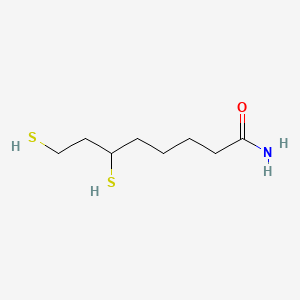| MeSH term | MeSH ID | Detail |
|---|---|---|
| Parkinsonian Disorders | D020734 | 20 associated lipids |
Dihydrolipoamide
Dihydrolipoamide is a lipid of Fatty Acyls (FA) class. Dihydrolipoamide is associated with abnormalities such as Wiskott-Aldrich Syndrome. The involved functions are known as Citric Acid Cycle, Electron Transport, NADH oxidation, Oxidation and Oxidants. Dihydrolipoamide often locates in Mitochondria, Mitochondrial matrix and Chloroplasts. The associated genes with Dihydrolipoamide are Mutant Proteins, Recombinant Proteins, mycothione reductase, Genes, Mitochondrial and alanylproline.
Cross Reference
Introduction
To understand associated biological information of Dihydrolipoamide, we collected biological information of abnormalities, associated pathways, cellular/molecular locations, biological functions, related genes/proteins, lipids and common seen animal/experimental models with organized paragraphs from literatures.
What diseases are associated with Dihydrolipoamide?
Dihydrolipoamide is suspected in and other diseases in descending order of the highest number of associated sentences.
Related references are mostly published in these journals:
| Disease | Cross reference | Weighted score | Related literature |
|---|
Possible diseases from mapped MeSH terms on references
We collected disease MeSH terms mapped to the references associated with Dihydrolipoamide
PubChem Associated disorders and diseases
What pathways are associated with Dihydrolipoamide
There are no associated biomedical information in the current reference collection.
PubChem Biomolecular Interactions and Pathways
Link to PubChem Biomolecular Interactions and PathwaysWhat cellular locations are associated with Dihydrolipoamide?
Visualization in cellular structure
Associated locations are in red color. Not associated locations are in black.
Related references are published most in these journals:
| Location | Cross reference | Weighted score | Related literatures |
|---|
What functions are associated with Dihydrolipoamide?
Related references are published most in these journals:
| Function | Cross reference | Weighted score | Related literatures |
|---|
What lipids are associated with Dihydrolipoamide?
There are no associated biomedical information in the current reference collection.
What genes are associated with Dihydrolipoamide?
Related references are published most in these journals:
| Gene | Cross reference | Weighted score | Related literatures |
|---|
What common seen animal models are associated with Dihydrolipoamide?
There are no associated biomedical information in the current reference collection.
NCBI Entrez Crosslinks
All references with Dihydrolipoamide
Download all related citations| Authors | Title | Published | Journal | PubMed Link |
|---|---|---|---|---|
| Ortega-Galisteo AP et al. | S-Nitrosylated proteins in pea (Pisum sativum L.) leaf peroxisomes: changes under abiotic stress. | 2012 | J. Exp. Bot. | pmid:22213812 |
| Schriek S et al. | Detection of an L-amino acid dehydrogenase activity in Synechocystis sp. PCC 6803. | 2009 | J. Exp. Bot. | pmid:19213808 |
| Aranjuelo I et al. | Plant physiology and proteomics reveals the leaf response to drought in alfalfa (Medicago sativa L.). | 2011 | J. Exp. Bot. | pmid:20797998 |
| Vasquez-Robinet C et al. | Physiological and molecular adaptations to drought in Andean potato genotypes. | 2008 | J. Exp. Bot. | pmid:18535297 |
| Norton GJ et al. | Rice-arsenate interactions in hydroponics: whole genome transcriptional analysis. | 2008 | J. Exp. Bot. | pmid:18453530 |
| Katz E et al. | Label-free shotgun proteomics and metabolite analysis reveal a significant metabolic shift during citrus fruit development. | 2011 | J. Exp. Bot. | pmid:21841177 |
| Hallström T et al. | Dihydrolipoamide dehydrogenase of Pseudomonas aeruginosa is a surface-exposed immune evasion protein that binds three members of the factor H family and plasminogen. | 2012 | J. Immunol. | pmid:23071278 |
| Quintana E et al. | Dihydrolipoamide dehydrogenase (DLD) deficiency in a Spanish patient with myopathic presentation due to a new mutation in the interface domain. | 2010 | J. Inherit. Metab. Dis. | pmid:20652410 |
| Lee EH et al. | A Korean female patient with thiamine-responsive pyruvate dehydrogenase complex deficiency due to a novel point mutation (Y161C)in the PDHA1 gene. | 2006 | J. Korean Med. Sci. | pmid:17043409 |
| Gerards M et al. | Defective complex I assembly due to C20orf7 mutations as a new cause of Leigh syndrome. | 2010 | J. Med. Genet. | pmid:19542079 |
| Brautigam CA et al. | Crystal structure of human dihydrolipoamide dehydrogenase: NAD+/NADH binding and the structural basis of disease-causing mutations. | 2005 | J. Mol. Biol. | pmid:15946682 |
| Vijayakrishnan S et al. | Solution structure and characterisation of the human pyruvate dehydrogenase complex core assembly. | 2010 | J. Mol. Biol. | pmid:20361979 |
| MacGregor P and Matthews KR | New discoveries in the transmission biology of sleeping sickness parasites: applying the basics. | 2010 | J. Mol. Med. | pmid:20526573 |
| Ambrus A et al. | Inhibition of the alpha-ketoglutarate dehydrogenase-mediated reactive oxygen species generation by lipoic acid. | 2009 | J. Neurochem. | pmid:19393031 |
| Katsuki H et al. | Superoxide dismutase activity in organotypic midbrain-striatum co-cultures is associated with resistance of dopaminergic neurons to excitotoxicity. | 2001 | J. Neurochem. | pmid:11238718 |
| Klivenyi P et al. | Mice deficient in dihydrolipoamide dehydrogenase show increased vulnerability to MPTP, malonate and 3-nitropropionic acid neurotoxicity. | 2004 | J. Neurochem. | pmid:15009635 |
| Starkov AA et al. | Mitochondrial alpha-ketoglutarate dehydrogenase complex generates reactive oxygen species. | 2004 | J. Neurosci. | pmid:15356189 |
| Ramos EI et al. | 2,3-diphenyl-1,4-naphthoquinone: a potential chemotherapeutic agent against Trypanosoma cruzi. | 2009 | J. Parasitol. | pmid:18788881 |
| Campanucci VA et al. | A novel O2-sensing mechanism in rat glossopharyngeal neurones mediated by a halothane-inhibitable background K+ conductance. | 2003 | J. Physiol. (Lond.) | pmid:12640017 |
| Holbrook ED et al. | Definition of the extracellular proteome of pathogenic-phase Histoplasma capsulatum. | 2011 | J. Proteome Res. | pmid:21291285 |
